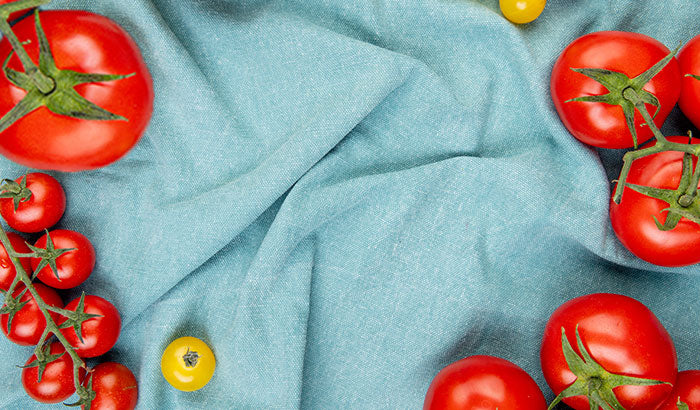What's New at Wazoodle
What's New

Food-safe fabrics open a new door of possibilities for how fabrics can be used. We live in a world full of plastic and other non-biodegradable materials that are clogging our landfills and polluting our oceans. Food-safe fabrics are just one step we can take to protect our earth from even worse levels of waste.
When looking for new ways to help save the planet, food-safe fabrics can do a world of good. And as it turns out, there are multiple kinds of food-safe fabrics, ranging from burp cloths to sandwich bags to grocery shopping bags and everything in between.
Are you looking for food-safe fabric that’s absorbent? What about organic fabric? A wicking one? Something made of mesh? All of those options exist in eco-friendly fabrics that will make your life easier, keep your wallet fuller, and help Mother Nature.
Together we can save the planet!
One of the top qualities that many individuals look for in a fabric – whether or not it is food safe – is absorbency. An absorbent material is designed to capture and hold any moisture and liquid that it comes in contact with, instead of allowing it to go through the material.
Absorbency is an essential component of a food-safe fabric that will store liquids, such as beverages, broths, or soups. An absorbent fabric is different from a hydrophobic or waterproof fabric.
Hydrophobic fabric causes liquid or moisture to bead up and roll off the fabric and is usually made using chemicals, which you don’t want in your product, so let’s skip these altogether.
Waterproof fabric absorbs liquid or moisture but doesn’t allow it to pass through the fabric. All three have excellent qualities that, when combined, make a fabric nearly unstoppable.
Of course, it makes sense to want an absorbent fabric that’s also food safe, especially if it comes in contact with food or someone’s mouth. Many materials contain harmful chemicals that can make you sick if those chemicals make their way into your body. Altogether avoiding those chemicals and toxins is your best bet.
Are you looking for a food-safe, absorbent material? You’ll definitely want premium-quality fabrics with food-safe features. Check out Zorb FoodSAFE Super Absorbent fabrics.
The term “organic” is most often associated with food, but organic fabrics also exist. So, what exactly is an organic fabric? What sets it apart from non-organic materials?
First, organic fabrics are made with the least amount of environmental impact possible. Let’s look at organic cotton for a moment. It’s not the only organic, eco-friendly fabric, but it’s a great example.
Being organic starts with the cotton seeds, which are natural, untreated, and free of GMOs. Organic matter is used in the soil where the cotton seeds grow.
Once the cotton has grown, it’s harvested with natural defoliation, produced with non-toxic cornstarch, and whitened with safe peroxide. Because organic cotton is natural and non-toxic, it’s often a bio-based, biodegradable fabric.
On the other hand, non-organic cotton tends to make a more significant, negative impact on the environment. The cotton seeds are not organic, are often chemically treated, and contain GMOs. The soil where non-organic cotton grows isn’t treated with organic matter.
The harvesting, production, and whitening of non-organic cotton usually involve chemical treatments that include bleach and ammonia.
An organic food-safe fabric provides organic qualities while being safe for food. It’s a win-win. Check out ProECO FoodSAFE Organic Cotton fabrics for a premium-quality option.
A wicking fabric accomplishes two things. First, it moves moisture to the fabric’s outer surface, not allowing it to live inside it. This prevents bacteria and mold from growing on the fabric.
Second, it dries quickly, preventing moisture from saturating the fabric. Many wicking fabrics are hydrophobic, causing moisture or other liquid to bead up and roll off the fabric.
You have a few options for a wicking, food-safe fabric. Those options include cotton, jersey mesh, soft fleece, and interlock. It all depends on what you’ll be using the fabric for. Typically speaking, you can use a wicking fabric as an interlining layer for added protection or as the sole layer for use with foods such as milk, coffee, tea, stews, soups, or curries.
Sturdy mesh is a unique, food-safe option that is great for baking or cooking. Food companies like Tyson Foods have used mesh in their cooking processes.
As an example, the multi-purpose mesh can be sewn into sleeves that go on cooking trays. Since these sleeves are food safe, it’s okay for food to repeatedly touch them. These sleeves eliminate using single-use ones used to remove food from ovens.
Sturdy mesh is highly durable, lasting for an entire year before needing replacement. Plus, it can withstand the heat of the kitchen – literally.
Of course, food-safe mesh fabric can be used for anything food-related you can think of; you’re not limited to using the fabric as cooking sleeves. Another eco-friendly option includes packaging food items in the mesh instead of using disposable, single-use wrappers.
For food-safe mesh fabric, we recommend FoodSAFE Sturdy Multipurpose Mesh.
Fabrics are instrumental in reducing our carbon footprint. Food-safe fabrics prevent harmful chemicals and toxic finishes from making their way into our food and our bodies. Keeping us healthy is just as important as keeping the environment safe.
That’s why Wazoodle Fabrics offers so many food-safe fabric options. We want to ensure our customers have as many options as possible to best suit their needs. We can all do our part to save the environment by making small, everyday changes.
Shop our collection of FoodSAFE fabrics, and contact us if you have any questions regarding any of our products. Wazoodle Fabrics has everything you need, including 4x4 swatch kits you can order to find the right fabric before ordering yards or rolls.
Visit Wazoodle.com to get started with your swatch kits today!